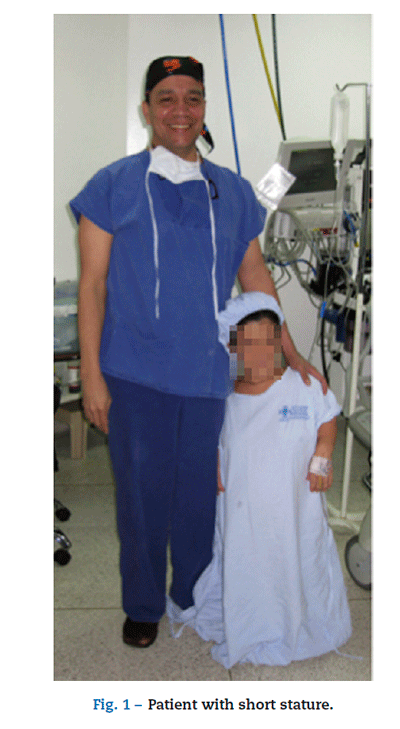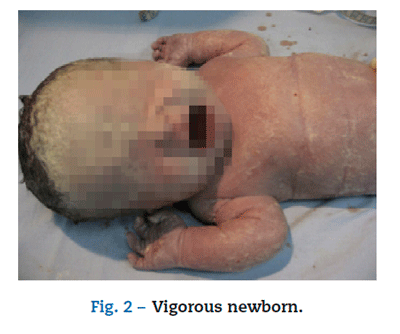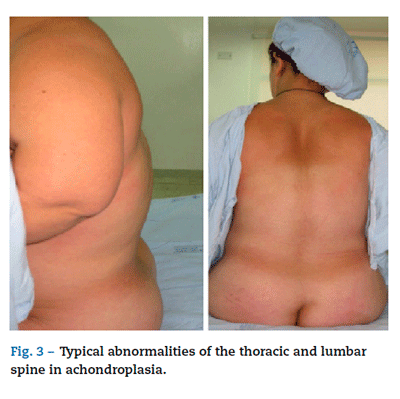Services on Demand
Journal
Article
Indicators
-
 Cited by SciELO
Cited by SciELO -
 Access statistics
Access statistics
Related links
-
 Cited by Google
Cited by Google -
 Similars in
SciELO
Similars in
SciELO -
 Similars in Google
Similars in Google
Share
Colombian Journal of Anestesiology
Print version ISSN 0120-3347
Rev. colomb. anestesiol. vol.40 no.4 Bogotá Oct./Dec. 2012
https://doi.org/10.1016/j.rca.2012.07.002
http://dx.doi.org/10.1016/j.rcae.2012.07.004
Case report
Anesthesia for cesarean section in a patient with achondroplasia
Anestesia para cesárea en paciente con acondroplasia
Walter Osorio Rudasa,*, Nury Isabel Socha Garciaa, Alejandro Upeguia, Ángela Ríos Medinab, Adrian Moranc, Oscar Aguirre Ospinab, Carlos Riverad
a MD, Specialist in Anesthesiology and Resuscitation, Unidad Materno infantil, Clínica Universitaria Pontifica Bolivariana, Medellín, Colombia
b MD, Specialist in Anesthesiology and Resuscitation, Universidad de Caldas, Manizales, Colombia
c MD, Resident of Anesthesiology and Resuscitation, Universidad de la Sabana, Bogotá, Colombia
d MD, Resident of Anesthesiology and Resuscitation, Universidad Sur Colombiana, Huila, Colombia
* Please cite this article as: Osorio Rudas W, et al. Anestesia para cesárea en paciente con acondroplasia.
* Corresponding author at: Ctra 82 A No. 32 B 147, Casa 110, Medellín, Colombia. E-mail address: walterosorio1@gmail.com (W. Osorio Rudas).
© 2012 Published by Elsevier España, S.L. on behalf of Sociedad Colombiana de Anestesiología y Reanimación.
ARTICLE INFO
Article history: Received 13 January 2012 Accepted 13 May 2012 Available
online 1 September 2012
Abstract
Introduction:Cesarean section under general anesthesia is recommended in achondroplastic pregnant patients; however, the use of conductive techniques has been recently reported, with acceptable results.
Objective: To describe the anesthesia management in an achondroplastic patient scheduled for C-section under combined spinal-epidural anesthesia.
Methods and results: We present the case of a first pregnancy in a patient with achondroplasia, height 110 cm and 37 weeks of gestation. The patient underwent cesarean section under ultrasound-guided conductive anesthesia, using a titrated mixture of local anesthetic and opiate, with good results for the mother and child.
Conclusions: Conductive anesthesia is an option in C-section in patients with achondropla-sia. Although there are no clear recommendations to guide a safe access to the neuroaxis or to administer anesthetic agents at this level, ultrasound and the titrated administration of neuraxial drugs (epidural, epidural-spinal and continuous spinal) for improved safety and efficacy of the technique in this type of patients may be considered.
Keywords: Anesthesia Obstetrical anesthesia Cesarean section Achondroplasia
© 2012 Published by Elsevier España, S.L. on behalf of Sociedad Colombiana de Anestesiología y Reanimación.
Resumen
Introducción: En gestantes acondroplásicas se recomienda el parto por cesárea con anestesia general; sin embargo, recientemente se ha reportado el uso de técnicas conductivas con resultados adecuados.
Objetivo: Describirel manejo anestésico de una paciente con acondroplasia programada para cesárea utilizando anestesia combinada espinal-epidural.
Métodos y resuItados: Mostramos el caso de una primigestante acondroplásica con 110 cm de estatura y embarazo de 37 semanas, en quien se realizó cesárea con anestesia conductiva guiada por ecografía, empleando una mezcla titulada de anestésico local y opiáceo, con buenos resultados para la madre y el hijo.
Conclusiones: La anestesia conductiva es una alternativa en la cesárea de pacientes con acondroplasia. Aunque no existen recomendaciones claras para orientar el acceso seguro al neuroeje ni para administrar medicamentos anestésicos a este nivel, se puede considerar el uso de la ecografía y la administración titulada de fármacos neuroaxiales (epidural, epidural-espinal y espinal continua) para mejorar la seguridad y la eficacia de la técnica en este tipo de pacientes.
Palabras clave: Anestesia, Anestesia obstétrica, Cesárea, Acondroplasia
© 2012 Publicado por Elsevier España, S.L. en nombre de Sociedad Colombiana de Anestesiología y Reanimación.
Case description
First pregnancy in an achondroplastic 29-year old with 37 weeks of gestation was scheduled for Cesarean section. Personal history of acid-peptic disease and ultrasound finding of fetus with achondroplasia was given; the results of the physical examination were: height 110 cm (see Fig. 1), blood pressure (BP): 120/70, heart rate (HR): 75 min, weight 41 kg and BMI: 33,9: short limbs and thoracolumbar kyphoscoliosis. No predictors of difficult airway or cardiopulmonary/neurological findings.
The patient requested to be awake during the birth of the baby and then discuss the risks and benefits of the anesthetic strategy; a combined spinal-epidural technique is considered.
Prior to administering the anesthesia, the patient received 50 mg of ranitidine and 10 mg of metoclopramide IV under basic ASA monitoring, including preparation of a difficult airway kit.
With the patient in sitting position, following ultrasound measurement, the epidural space L2-L3 is identified at 3.5 cm from the skin; using a tuohy #18 needle and continuous loss of resistance with saline solution, the epidural space was accessed free of complications. A multi-orifice epidural #20 catheter was introduced and fixed to the skin. The catheter aspiration test was negative and the decision is made not to perform a test dose.
After three WhitacreTM 25-needle taps the subarachnoid space in L3-L4 was identified. 5mg of hyperbaric bupiva-caine with 64 xg of morphine and 16 xg of fentanyl were injected. The patient did not experience any numbness during the procedure. Sensory block was verified up to T4. BP at 5 min was 80/40 and HR 72/min. 8 mg of etilephrine were required to maintain the systolic BP > 90 mmHg and the mean BP>50mmHg. The patient experienced discomfort during peritoneal traction and hence 60 mg of epidural lidocaine without epinephrine were administered and a slow IVbolus of 48 xg of remifentanyl. The newborn had an apgar score of 8 at one minute and 10 at 5 min (see Fig. 2). In total, 1000 cc ofcrys-talloids were administered and the procedure was completed free from complications.
Discussion
Dwarfism is defined as the failure to reach a stature over 148 cm1 and achondroplasia is the most frequent cause.2 This is a hereditary bone metabolism disorder with a prevalence of 1/26,000 live births.3 It is an autosomal dominant transmission4 and in 80% of the cases is a spontaneous genetic mutation.5
Achondroplasia is characterized by short stature, macro-cephalus with prominent forehead, depressed nasal bridge, protuberant buttocks and abdomen, short limbs, particularly the proximal segment, lumbar hyperlordosis and thoracic kyphoscoliosis6 (see Fig. 3). Symptomatic spinal stenosis usually does not manifest itself before the fourth or fifth decade of life, when osteophytes, kyphosis, scoliosis and disc hernias cause additional narrowing of the spinal canal.7
Women are often affected and have low fertility rates.8 Delivery is usually through Cesarean section because of the cephalopelvic disproportion.9
The choice of anesthesia for C-section in achondroplastic patients has been controversial,10 but general anesthesia is usually preferred,11 though it is particularly challenging since the anatomic alterations further compound the typical morphological changes during pregnancy.12
General anesthesia presents specific risks such as: tendency to obstruct the airway; cervical instability13 and difficulties for direct laryngoscopy as a result of rigid temporo-madibular joints, macroglossia and pharyngeal stenosis.14 The passage of the endotracheal tube may be difficult and there is a need to choose a small tube, in accordance with the weight of the patient rather than age.13 Odontoid process dysplasia is a frequent finding and is accompanied in some cases by atlanto-axial instability and bone marrow compression that may deteriorate with orotracheal intubation maneuvers.15 Additionally, dystrophy and thoracic kyphosco-liosis predispose for the development of restrictive lung disease.16
Heart abnormalities predispose to ischemic events.17 Subarachnoidal anesthesia may prove technically challenging and its distribution may be inappropriate due to lumbar hyperlordosis, marked thoracic kyphoscoliosis, progressive narrowing of the inter-peduncular space and generalized stenosis of the spinal or epidural space.18 Some authors do not recommend this approach to prevent blaming the anesthetic technique for any neurological abnormality caused by the spinal deformity.19
There are no literature reports of neurologic injury in achondroplastic patients with conductive anesthesia; however, the risk is undeniable and any neurological disorders must be appropriately registered in the clinical record and post-block evaluations should be performed for early detection.
Whichever the technique, aorta-caval compression may be severe20 resulting in hypotension that requires uterine displacement, fluids co-load and rapid administration of vasopressants.21 Short limbs and obesity may hinder non-invasive BP measurement and hence occasionally intra-arterial measurements are needed.22
Due to existing reports of failed subarachnoidal anesthesia for the management of Cesarean sections in patients with achondroplasia,23 excellent results were achieved with the use of a combined spinal-epidural technique to enable epidural titration of the anesthetic agent if needed.22
In sum, we think that conductive anesthesia is an option for the management of achondroplastic patients undergoing Cesarean section; however, in the light of inter-individual anatomic variations of the spine, ultrasound guided lumbar tap should be considered to facilitate the approach and reduce the risk of neurological complications. Likewise, neuraxial titration of local anesthetic agents with techniques such as epidural, combined spinal-epidural or continuous spinal is needed. Finally, even when selecting regional techniques, do not ever rule out the possibility of general anesthesia and always be prepared for difficult airway management.
Funding
Own resources.
Conflict of interests
None.
REFERENCIAS1. Laederich MB, Horton WA. Achondroplasia: pathogenesis and implications for future treatment. Curr Opin Pediatr. 2010;22:516-23.
2. Trotter TL, Hall JG. American Academy of Pediatrics Committee on Genetics. Health supervision for children with achondroplasia. Pediatrics. 2005;116:771-83.
3. Crosby ET. Muscoloskeletal disorders. En: Chestnut DH, editor. Obstetric Anesthesia. Principles and Practice, 48. Philadelphia: Mosby; 2009. p. 1048-9.
4. Baujat G, Legeai-Mallet L, Finidori G, Cormier-Daire V, Le Merrer M. Achondroplasia. Best Pract Res Clin Rheumatol. 2008;22:3-18.
5. Richette P, Bardin T, Stheneur C. Achondroplasia: from genotype to phenotype. Joint Bone Spine. 2008;75:125-30.
6. Shirley ED, Ain MC. Achondroplasia: manifestations and treatment. J Am Acad Orthop Surg. 2009;17:231-41.
7. Ferrante L, Acqui M, Mastronardi L, Celli P, Fortuna A. Stenosis of the spinal canal in achondroplasia. Ital J Neurol Sci. 1991;12:371-5.
8. Stratbucker WB. In brief: Achondroplasia. Pediatr Rev. 2009;30:114-5.
9. Allanson JE, Hall JG. Obstetric and gynecologic problems in women with chondrodystrophies. Obstet Gynecol. 1986;67:74-8.
10. Brimacombe JR, Caunt JA. Anaesthesia in a gravid achondroplastic dwarf. Anaesthesia. 1990;45: 132-4.
11. Walts LF, Finerman G, Wyatt GM. Anaesthesia for dwarfs and other patients of pathological small stature. Can Anaesth Soc J. 1975;22:703-9.
12. Ratner EF, Cohen SE. Parturients of short stature. En: Gambling DR, Douglas MJ, editores. Obstetric Anesthesia and Uncommon Disorders. 1st ed. Philadelphia: W.B. Saunders Company; 1998. p. 183-94.
13. Berkowitz ID, Raja SN, Bender KS, Kopits SE. Dwarfs: pathophysiology and anesthetic implications. Anesthesiology. 1990;73:739-59.
14. Mayhew JF, Katz J, Miner M, Leiman BC, Hall ID. Anaesthesia for the achondroplastic dwarf. Can Anaesth Soc J. 1986;33:216-21.
15. Dvorak DM, Rusnak RA, Morcos JJ. Multiple trauma in the achondroplastic dwarf: an emergency medicine physician perspective case report and literature review. Am J Emerg Med. 1993;11:390-5.
16. Stokes DC, Phillips JA, Leonard CO, Dorst JP, Kopits SE, Trojak JE, et al. Respiratory complications of achondroplasia. J Pediatr. 1983;102:534-41.
17. Tagarakis GI, Karangelis D, Baddour AJ, Desimonas N, Tsantsaridou A, Daskalopoulos ME, et al. Coronary artery surgery in a man with achondroplasia: a case report. J Med Case Reports. 2010;4:348.
18. Palomero MA, Vargas MC, Pelaez EM, Rodriguez-Ceron A, Sanchez-Conde P, Muriel C. Spinal anaesthesia for emergency Caesarean section in an achondroplastic patient. Eur J Anaesthesiol. 2007;24:981-2.
19. Bergstrom K, Laurent U, Lundberg PO. Neurological symptoms in achondroplasia. Acta Neurol Scand. 1971;47:59-70.
20. Huang J, Babins N. Anesthesia for cesarean delivery in an achondroplastic dwarf: a case report. AANA J. 2008;76:435-6.
21. Morrow MJ, Black IH. Epidural anaesthesia for caesarean section in an achondroplastic dwarf. Br J Anaesth. 1998;81:619-21.
22. Hecht JT, Hood OJ, Schwartz RJ, Bernhardt BA, Hennesey JC, Horton WA. Obesity in achondroplasia. Am J Med Genet. 1988;31:597-602.
23. De Renzo JS, Vallejo MC, Ramanathan S. Failed regional anesthesia with reduced spinal bupivacaine dosage in a parturient with achondroplasia presenting for urgent cesarean section. Int J Obstet Anesth. 2005;14:175-8.
1. Laederich MB, Horton WA. Achondroplasia: pathogenesis and implications for future treatment. Curr Opin Pediatr. 2010;22:516-23. [ Links ]
2. Trotter TL, Hall JG. American Academy of Pediatrics Committee on Genetics. Health supervision for children with achondroplasia. Pediatrics. 2005;116:771-83. [ Links ]
3. Crosby ET. Muscoloskeletal disorders. En: Chestnut DH, editor. Obstetric Anesthesia. Principles and Practice, 48. Philadelphia: Mosby; 2009. p. 1048-9. [ Links ]
4. Baujat G, Legeai-Mallet L, Finidori G, Cormier-Daire V, Le Merrer M. Achondroplasia. Best Pract Res Clin Rheumatol. 2008;22:3-18. [ Links ]
5. Richette P, Bardin T, Stheneur C. Achondroplasia: from genotype to phenotype. Joint Bone Spine. 2008;75:125-30. [ Links ]
6. Shirley ED, Ain MC. Achondroplasia: manifestations and treatment. J Am Acad Orthop Surg. 2009;17:231-41. [ Links ]
7. Ferrante L, Acqui M, Mastronardi L, Celli P, Fortuna A. Stenosis of the spinal canal in achondroplasia. Ital J Neurol Sci. 1991;12:371-5. [ Links ]
8. Stratbucker WB. In brief: Achondroplasia. Pediatr Rev. 2009;30:114-5. [ Links ]
9. Allanson JE, Hall JG. Obstetric and gynecologic problems in women with chondrodystrophies. Obstet Gynecol. 1986;67:74-8. [ Links ]
10. Brimacombe JR, Caunt JA. Anaesthesia in a gravid achondroplastic dwarf. Anaesthesia. 1990;45: 132-4. [ Links ]
11. Walts LF, Finerman G, Wyatt GM. Anaesthesia for dwarfs and other patients of pathological small stature. Can Anaesth Soc J. 1975;22:703-9. [ Links ]
12. Ratner EF, Cohen SE. Parturients of short stature. En: Gambling DR, Douglas MJ, editores. Obstetric Anesthesia and Uncommon Disorders. 1st ed. Philadelphia: W.B. Saunders Company; 1998. p. 183-94. [ Links ]
13. Berkowitz ID, Raja SN, Bender KS, Kopits SE. Dwarfs: pathophysiology and anesthetic implications. Anesthesiology. 1990;73:739-59. [ Links ]
14. Mayhew JF, Katz J, Miner M, Leiman BC, Hall ID. Anaesthesia for the achondroplastic dwarf. Can Anaesth Soc J. 1986;33:216-21. [ Links ]
15. Dvorak DM, Rusnak RA, Morcos JJ. Multiple trauma in the achondroplastic dwarf: an emergency medicine physician perspective case report and literature review. Am J Emerg Med. 1993;11:390-5. [ Links ]
16. Stokes DC, Phillips JA, Leonard CO, Dorst JP, Kopits SE, Trojak JE, et al. Respiratory complications of achondroplasia. J Pediatr. 1983;102:534-41. [ Links ]
17. Tagarakis GI, Karangelis D, Baddour AJ, Desimonas N, Tsantsaridou A, Daskalopoulos ME, et al. Coronary artery surgery in a man with achondroplasia: a case report. J Med Case Reports. 2010;4:348. [ Links ]
18. Palomero MA, Vargas MC, Pelaez EM, Rodriguez-Ceron A, Sanchez-Conde P, Muriel C. Spinal anaesthesia for emergency Caesarean section in an achondroplastic patient. Eur J Anaesthesiol. 2007;24:981-2. [ Links ]
19. Bergstrom K, Laurent U, Lundberg PO. Neurological symptoms in achondroplasia. Acta Neurol Scand. 1971;47:59-70. [ Links ]
20. Huang J, Babins N. Anesthesia for cesarean delivery in an achondroplastic dwarf: a case report. AANA J. 2008;76:435-6. [ Links ]
21. Morrow MJ, Black IH. Epidural anaesthesia for caesarean section in an achondroplastic dwarf. Br J Anaesth. 1998;81:619-21. [ Links ]
22. Hecht JT, Hood OJ, Schwartz RJ, Bernhardt BA, Hennesey JC, Horton WA. Obesity in achondroplasia. Am J Med Genet. 1988;31:597-602. [ Links ]
23. De Renzo JS, Vallejo MC, Ramanathan S. Failed regional anesthesia with reduced spinal bupivacaine dosage in a parturient with achondroplasia presenting for urgent cesarean section. Int J Obstet Anesth. 2005;14:175-8. [ Links ]











 text in
text in 




